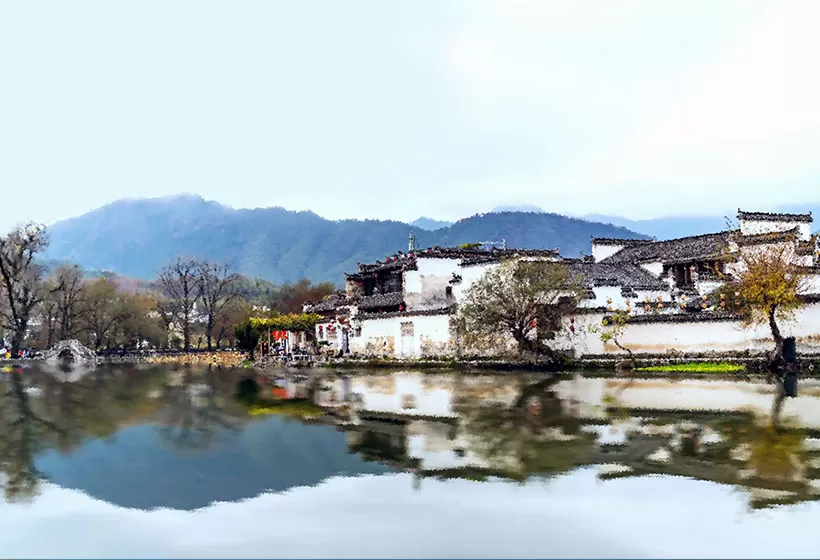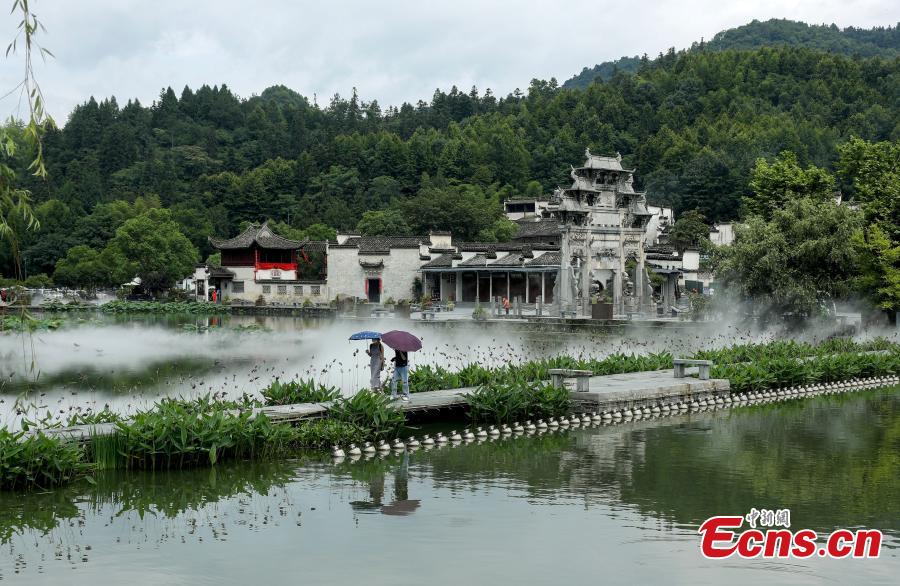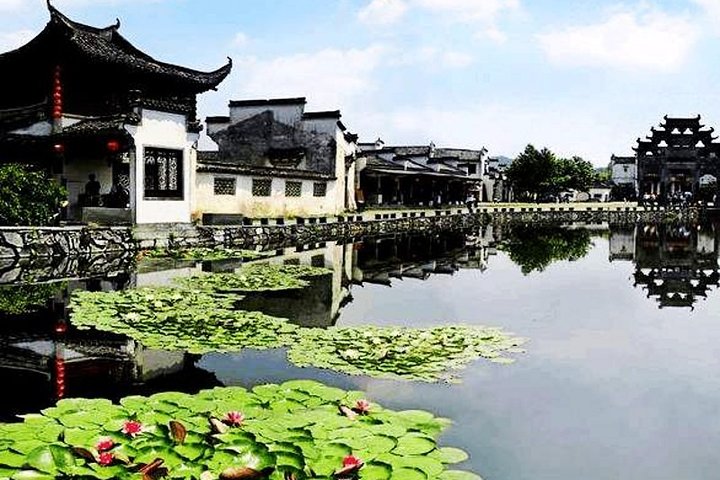Discover Xidi Ancient Village: A Journey Through China’s Historical Treasures
An Essential Guide to Visiting Xidi Ancient Village
Nestled amidst the picturesque landscapes of Anhui Province, Xidi Ancient Village is a captivating portal to China’s rich historical tapestry. Renowned for its stunning Hui-style architecture, this UNESCO World Heritage Site boasts over 300 well-preserved ancient residences, each exuding timeless elegance with intricate wood, stone, and brick carvings that tell stories of a bygone era. As you wander through its winding, bluestone-paved lanes, you’ll feel as though you’ve stepped into a living museum, where every corner reveals a blend of artistry and tradition.
This guide is designed to help you uncover the hidden gems of Xidi Ancient Village, from its historical significance and architectural marvels to the must-see sites and experiences that make this destination truly unique. We’ll delve into the fascinating history of the village, highlight key attractions like the stunning Hu Wenguang Archway and the serene Jing’ai Hall, and offer practical tips to enhance your visit. Whether you’re an architecture aficionado, a photography lover, or simply seeking a serene escape into China’s cultural heritage, Xidi Ancient Village promises a memorable journey through time.
In This Guide
- An Essential Guide to Visiting Xidi Ancient Village
- The Rich History and Legends of Xidi Ancient Village
- Main Highlights: What You Absolutely Can’t Miss
- Planning Your Visit: A Practical Guide
- Tickets: Prices, Booking, and Tips
- How to Get There: A Complete Transportation Guide
- Local Cuisine and Accommodation Nearby
- Frequently Asked Questions
- Final Thoughts on Your Trip
The Rich History and Legends of Xidi Ancient Village
Xidi Ancient Village is more than just a picturesque destination; it is a living testament to centuries of history, culture, and artistry. This charming village, nestled in the lush landscapes of Anhui Province, invites travelers to delve into its rich past, marked by the triumphs and trials of its inhabitants.
A Journey Through Time
Origins in the Northern Song Dynasty
The roots of Xidi Village can be traced back to the Northern Song Dynasty (960–1127), a period known for its flourishing arts and trade. Established nearly 1,000 years ago, the village was strategically located along a river, which served as a vital courier station. This early significance laid the foundation for Xidi’s growth and prosperity, attracting merchants and scholars drawn to the bustling economy and cultural vibrancy of the region.
The Rise of the Hu Family
As time progressed, the village became closely associated with the Hu family, whose members played a pivotal role in its development during the Ming (1368–1644) and Qing (1644–1912) Dynasties. The Hu family’s wealth was not merely amassed through commerce; many members excelled in the imperial examination system, earning prestigious positions within the government. Their success facilitated the construction of numerous ancestral halls, residences, and memorial archways, many of which stand today as enduring symbols of the village’s heritage.
The Legend of Li Shimin
Among the many legends that enrich the narrative of Xidi, one stands out: the tale of Li Shimin, a revered emperor of the Tang Dynasty (618–907). According to local lore, the ancestors of the Hu family were direct descendants of Li Shimin’s son. Fleeing the political turmoil of their time, they adopted the surname Hu and settled in Xidi. This legendary connection to imperial lineage not only elevated the status of the Hu family but also ingrained a sense of pride and historical significance within the village.
Architectural Heritage
UNESCO World Heritage Designation
Xidi’s architectural marvels, characterized by their elegant gray brick walls, dark-tiled roofs, and intricate carvings, earned the village a spot on the UNESCO World Heritage List in 2000. This recognition, shared with nearby Hongcun Village, underscores the global importance of Xidi as an exemplar of Huizhou architecture. Visitors can wander through narrow, winding streets, marveling at the “Three Carvings of Huizhou”—wood, stone, and brick—which showcase the village’s artisanal craftsmanship.
Cultural Continuity
A Living Museum
Today, Xidi Ancient Village serves as an open-air museum, where ancient customs and traditions continue to thrive. The villagers, many of whom still bear the Hu surname, maintain their cultural heritage through traditional arts such as woodcarving, mural painting, and the preservation of historical architecture. The atmosphere is imbued with the spirit of the Ming and Qing Dynasties, as antique furniture and decor reflect the lifestyle of Hui merchants and scholars of yesteryear.
Legends in Everyday Life
Visitors will discover that legends are woven into the very fabric of daily life in Xidi. The village’s homes contain stories in every corner—from the intricately carved doorframes depicting mythical creatures to the scenic gardens that echo the philosophies of harmony and balance. Each residence, with its unique design and artistry, tells a story of its inhabitants, their dreams, hopes, and legacies.
Conclusion: The Timeless Allure of Xidi
Xidi Ancient Village is not just a destination; it is a portal into the past, where history and legend converge. As travelers explore its ancient streets, they are invited to witness a way of life that has remained largely unchanged for centuries. From the lore of its founding families to the breathtaking architecture that adorns its landscape, Xidi is a captivating chapter in China’s rich tapestry of culture and history, waiting to be explored and cherished by generations to come.

Xidi Ancient Village.
Main Highlights: What You Absolutely Can’t Miss
Hu Wenguang Archway
Standing majestically at 12.3 meters, the Hu Wenguang Archway is a stunning tribute to the achievements of its namesake from the Ming Dynasty. This four-pillared structure, crafted from local Yixian bluestone, showcases intricate carvings of mythical creatures and floral patterns. As you gaze upward at the detailed artistry, take a moment to appreciate the archway’s significance as the only well-preserved stone archway in the village. Tip: Visit early in the morning to capture beautiful photographs with soft lighting and fewer tourists around.
Jing’ai Hall
Dive into the heart of Xidi’s cultural heritage by visiting Jing’ai Hall, the main ancestral hall of the Hu family. This architectural marvel serves as an important site for family ceremonies and showcases the clan’s deep-rooted traditions. The hall’s design is a feast for the eyes, featuring elaborate wood, brick, and stone carvings that narrate the family’s history. Tip: Don’t miss the chance to speak with local guides who can provide fascinating insights into the significance of the hall and its rituals.
Zhuimu Hall
Built to honor Emperor Li Shimin during the Qing Dynasty, Zhuimu Hall offers a glimpse into the village’s noble lineage. The solemn architecture, adorned with stunning carvings, reflects the ancestral pride of the Hu family. Explore the interior to find the main altar and appreciate the beautiful artistry on the walls and ceilings. Tip: Look for the unique symbolism in the carvings, which often reflect the family’s aspirations and values.
Lingyun Attic (Zouma Lou)
Reaching about 15 meters in height, Lingyun Attic is not only a landmark of Hui architecture but also a fantastic viewpoint to survey Xidi’s picturesque landscape. The attic’s elegant design and elevated position provide a perfect backdrop for panoramic photographs of the village and surrounding mountains. Tip: Plan your visit around sunset for breathtaking views as the village is bathed in golden light.
Dafu Di Residence
Step back in time as you explore Dafu Di, a quintessential example of Hui-style architecture. This residence is characterized by its grand scale and detailed carvings, with horse-head walls and intricately designed wooden doors. The “Xiu Tower” facing the street adds to the charm, where local legends say the Hu family’s daughter would toss embroidery balls to choose her future husband. Tip: Take a guided tour to fully appreciate the stories behind the architecture and the life of Hui merchants.
West Garden (Xi Yuan)
This beautiful private estate of Hu Wenzhao is a harmonious blend of residence and garden, reflecting the classic design principles of Suzhou gardens. As you wander through its three interconnected courtyards, take in the peaceful atmosphere that this garden-style residence embodies. Tip: Bring a sketchbook or camera; the serene ambiance and exquisite layout make it a perfect spot for artists and photographers.
Night Tour Experience
As dusk falls, Xidi Ancient Village transforms into a magical landscape illuminated by a stunning light show. Begin your night adventure at Mingjing Lake, where the fountain and water curtain shows set the stage for an enchanting evening. The lights reflect off the ancient structures, creating a vibrant spectacle that highlights the village’s beauty in a whole new way. Tip: Follow the recommended route to ensure you don’t miss any highlights, and wear comfortable shoes to stroll through the charming streets.

Xidi Ancient Village.
Planning Your Visit: A Practical Guide
Best Time to Visit
The ideal months to explore Xidi Ancient Village are from March to May and September to November. During these seasons, the weather is mild and the scenery is particularly stunning. In spring, you can witness blooming flowers and lush greenery, while autumn offers a spectacular array of colors as the leaves change. Avoid the peak summer months if you prefer a quieter experience, as they can attract larger crowds.
Recommended Itinerary
To make the most of your visit, plan for a 4-5 hour itinerary. Here’s a suggested schedule:
- Arrival and Orientation (30 minutes)
-
Start at the main entrance and grab a map. Familiarize yourself with the village layout.
-
Hu Wenguang Archway (30 minutes)
-
Admire the intricate carvings and take some photos of this historic structure.
-
Jing’ai Hall (30 minutes)
-
Explore the ancestral hall to understand the cultural significance of family in Hui traditions.
-
Stroll Through the Streets (1 hour)
-
Wander the narrow alleys, taking in the architecture and discovering local shops.
-
Visit Key Residences (1.5 hours)
-
Don’t miss Dafu Di and the East Garden for their stunning designs and stories.
-
Lingyun Attic (30 minutes)
-
Climb up for a panoramic view of the village.
-
Night Tour (Optional)
- Consider returning after sunset to enjoy the enchanting light show illuminating the village.
Photography Tips
- Golden Hour: The best times for photography are early morning or late afternoon when the light is soft. Capture the village bathed in golden hues.
- Details Matter: Focus on the intricate carvings, unique windows, and horse-head walls. Close-up shots can reveal the craftsmanship of Hui architecture.
- Panoramic Shots: For sweeping views, head to Lingyun Attic, which provides a stunning perspective of the village.
- Night Photography: If you’re staying for the night tour, bring a tripod for long exposure shots to capture the illuminated village.
What to Wear
- Comfortable Footwear: Expect to walk on bluestone paths and navigate narrow alleys, so wear sturdy shoes.
- Layered Clothing: The temperature can vary significantly throughout the day, especially in spring and autumn. Dress in layers to stay comfortable.
- Sun Protection: Bring a hat, sunglasses, and sunscreen if you’re visiting during the warmer months.
Insider Tips
-
Engage with Locals: Many villagers are artisans who continue traditional crafts. Take the time to chat and learn about their skills in woodcarving, painting, and more.
-
Try Local Snacks: Don’t miss out on tasting local delicacies such as Hui-style pastries and tea. Look for street vendors offering authentic treats.
-
Explore Beyond the Main Attractions: While famous sites are essential, venture into the smaller alleys and hidden courtyards for a more intimate experience of village life.
-
Visit During Festivals: If your visit coincides with local festivals, you’ll experience vibrant cultural displays, performances, and traditional customs.
-
Stay Overnight: For a truly immersive experience, consider staying in a guesthouse within the village. This allows you to enjoy the tranquility of Xidi after day-trippers have left.
By following this guide, you’ll be well-prepared to experience the charm and beauty of Xidi Ancient Village, making your trip both enriching and memorable.

Xidi Ancient Village.
Tickets: Prices, Booking, and Tips
Exploring the enchanting Xidi Ancient Village is a must for any traveler interested in ancient Chinese culture and architecture. To make your visit seamless, here’s what you need to know about ticketing, including prices, booking options, and essential tips.
| Ticket Type | Price (CNY) | Includes |
|---|---|---|
| Adult | 120 | Entrance to Xidi Ancient Village |
| Student (with ID) | 60 | Entrance to Xidi Ancient Village |
| Senior (60+) | 60 | Entrance to Xidi Ancient Village |
Booking Your Tickets
To avoid any last-minute hassles, it’s highly recommended to book your tickets in advance. You can purchase tickets through several options:
-
Official Website: Check the official tourism website for Xidi Ancient Village for online ticketing options.
-
Travel Agencies: Many travel agencies offer ticket packages that include transportation, guided tours, and other amenities. Booking through a reputable agency can also provide added convenience.
-
On-Site Purchase: While you can buy tickets at the entrance, be aware that peak tourist seasons may result in long lines and ticket shortages.
Tips for a Smooth Experience
-
Plan Ahead: Xidi Ancient Village is best enjoyed at a leisurely pace. Aim to spend 4-5 hours exploring the village to fully appreciate its architectural beauty and cultural significance.
-
Best Visiting Times: The ideal periods to visit are from March to May and September to November when the weather is pleasant and the scenery is at its peak.
-
Night Tours: If you can, consider experiencing the village at night when it is beautifully illuminated, providing a unique perspective of its charm.
By following these tips and securing your tickets in advance, you can ensure a memorable visit to one of China’s hidden gems!
How to Get There: A Complete Transportation Guide
Getting to Xidi Ancient Village
Xidi Ancient Village, a UNESCO World Heritage site, is a must-visit for travelers seeking to immerse themselves in the rich cultural heritage of Huizhou architecture. Nestled in Yixian County, Anhui Province, this picturesque village is easily accessible from several major cities, making it an ideal stop on your Huangshan journey.
From the Nearest Major City: Huangshan
By Train:
– Huangshan Railway Station to Yixian County:
– Duration: Approximately 1 hour
– Cost: Around CNY 20-50 (depending on the class)
– Frequency: Trains run several times daily. It’s best to check the schedule in advance, as it can vary.
By Bus:
– Huangshan Bus Station to Yixian County:
– Duration: 1 to 1.5 hours
– Cost: Approximately CNY 30
– Frequency: Buses depart regularly throughout the day, usually every 30 minutes.
By Car:
– Driving Distance: About 40 kilometers (25 miles) from Huangshan City to Xidi Village.
– Duration: Approximately 1 hour.
– Route: Take the G205 road south from Huangshan City, following signs to Yixian County. The village is well-marked.
From Other Major Cities
From Shanghai:
– By Train:
– Take a high-speed train from Shanghai to Huangshan North Railway Station.
– Duration: 4-5 hours.
– Cost: Around CNY 300-600.
– From Huangshan North, follow the above bus or car instructions to reach Xidi Village.
From Beijing:
– By Train:
– Take a high-speed train to Huangshan North Railway Station.
– Duration: Approximately 9-10 hours.
– Cost: CNY 500-800.
– Again, proceed to Yixian County using public transport or a rental car.
From Hangzhou:
– By Train:
– High-speed trains are available from Hangzhou to Huangshan North.
– Duration: About 2-3 hours.
– Cost: Approximately CNY 150-300.
– Follow the bus or car route to Xidi Village afterward.
Getting Around the Scenic Area
Once you arrive in Xidi Ancient Village, exploring on foot is the best way to appreciate its beauty and architecture. The village is compact, and its narrow, winding lanes are best navigated on foot.
Walking:
– Duration: Approximately 1.5 to 2 hours to see the main attractions.
– The village itself is a living museum, with over 300 ancient residences, ancestral halls, and beautiful scenery, making every corner worth exploring.
Bicycles and Electric Scooters:
– Rentals may be available in the area for those who prefer a quicker way to cover more ground, but be sure to check local availability and regulations.
Local Guides:
– Consider hiring a local guide to enhance your experience. They can provide insights into the architecture and history that you might miss on your own.
Tips for Travelers
- Best Time to Visit: March to May and September to November offer pleasant weather and stunning views of the surrounding landscape.
- Tickets: Entrance to Xidi Village is approximately CNY 120 per person.
- Prepare for Walking: Wear comfortable shoes and bring water, especially if you plan to explore the village’s many winding paths.
With its rich history and stunning architecture, Xidi Ancient Village is an unforgettable destination in the heart of Anhui Province. Whether traveling independently or as part of a guided tour, getting there and exploring the village is sure to be a highlight of your trip to China.

Xidi Ancient Village.
Local Cuisine and Accommodation Nearby
When visiting Xidi Ancient Village, indulging in local cuisine is as essential as exploring its architectural wonders. The region offers delectable dishes that reflect the rich culinary heritage of Huizhou. Here are some must-try local specialties:
Local Cuisine
-
Li Hongzhang Hotpot (李鸿章火锅): This unique hotpot pays homage to the famous Qing Dynasty statesman Li Hongzhang. Featuring a rich broth made from chicken, spices, and herbs, it’s served with an array of fresh vegetables and meats. Diners can customize their meal by cooking ingredients at the table, making it a social and interactive dining experience.
-
Braised Bamboo Shoots (红烧竹笋): A dish that perfectly embodies the essence of Huizhou cuisine, braised bamboo shoots are slow-cooked to enhance their natural sweetness. Often accompanied by savory sauces and spices, this delicacy is both refreshing and satisfying, showcasing the region’s love for fresh, local ingredients.
-
Steamed River Fish (清蒸河鱼): Freshwater fish from the nearby streams is a staple in Xidi. Steamed to perfection with ginger, scallions, and soy sauce, this dish highlights the delicate flavors of the fish while preserving its tenderness. It’s a must-try for seafood lovers looking to savor authentic Huizhou flavors.
-
Eight-Treasure Rice (八宝饭): For dessert, indulge in Eight-Treasure Rice, a fragrant glutinous rice dish adorned with an array of colorful toppings, including dried fruits, nuts, and red bean paste. This sweet treat is not only visually appealing but also a delightful way to end your meal, often enjoyed during festive occasions.
Accommodation Options
After a day of exploring the stunning landscapes and cultural gems of Xidi, you’ll want a comfortable place to rest. Here are a few accommodation options to suit various budgets and preferences:
-
Luxury: Anji Mountain Resort
Nestled amidst lush greenery, this luxurious resort offers expansive views of the surrounding mountains and rivers. With elegantly designed rooms, a full-service spa, and gourmet dining options, Anji Mountain Resort provides a serene escape while ensuring a top-tier experience. -
Boutique: Xidi Ancient Village Boutique Hotel
This charming boutique hotel reflects the traditional architecture of the area, with elegantly decorated rooms that blend modern comforts with classic Huizhou style. Guests can enjoy personalized service, a cozy atmosphere, and easy access to the village’s main attractions, making it a perfect choice for those seeking a unique cultural experience. -
Budget: Xidi Hostel
For travelers on a budget, Xidi Hostel offers a friendly and welcoming environment. With dormitory-style accommodations and private rooms available, it’s an excellent choice for backpackers and solo travelers. The hostel’s communal areas encourage socializing, and its central location makes it easy to explore the village on foot.
Whether savoring the local flavors or relaxing in thoughtfully chosen accommodations, your stay in Xidi Ancient Village promises to be a memorable blend of culture, comfort, and culinary delight.

Xidi Ancient Village.
Frequently Asked Questions
Frequently Asked Questions about Xidi Ancient Village
1. Is Xidi Ancient Village suitable for children and the elderly?
Yes, Xidi Ancient Village is generally suitable for families with children and elderly visitors. The village features well-paved paths, ancient architecture to explore, and plenty of open spaces for children to roam. However, some narrow alleyways and uneven surfaces may require caution, so it’s advisable to assist elderly visitors and ensure children’s safety.
2. How long should I plan to spend in Xidi Ancient Village?
A visit to Xidi Ancient Village typically requires about 4 to 5 hours. This timeframe allows you to explore the stunning architecture, visit key attractions like ancestral halls, and soak in the village’s rich cultural heritage. If you enjoy photography or leisurely strolls, consider extending your visit.
3. Are there English signs and guides available in the village?
While some signage in Xidi Ancient Village includes English translations, not all of them do. To enhance your experience, consider hiring a local guide who can provide insights into the village’s history and architecture, or download a translation app for assistance.
4. What is the best time to visit Xidi Ancient Village?
The ideal times to visit are from March to May and September to November. During these months, the weather is generally pleasant, and you can enjoy the vibrant scenery and cultural events. Visiting during these seasons also helps avoid the peak summer heat.
5. Is there an entrance fee to visit Xidi Ancient Village?
Yes, the entrance fee to Xidi Ancient Village is CNY 120 per person. This ticket grants you access to the village and its historical sites, ensuring that you can fully immerse yourself in its cultural atmosphere.
6. Are there dining options available in or near the village?
Yes, there are several dining options within Xidi Ancient Village and nearby. You can enjoy traditional Huizhou cuisine at local restaurants. It’s advisable to sample the village’s specialties, such as bamboo rice or Huizhou-style tofu.
7. Can I visit Xidi Ancient Village as a day trip from Huangshan Mountain?
Absolutely! Xidi Ancient Village is located approximately 40 kilometers from Huangshan Mountain, making it an excellent day trip destination. Many visitors combine their visit to both locations to experience the natural beauty of Huangshan and the cultural richness of Xidi.
8. Are there any amenities like restrooms and resting areas in the village?
Yes, Xidi Ancient Village is equipped with basic amenities, including public restrooms and resting areas. However, it’s a good idea to carry some essentials with you, as facilities may be limited in certain areas of the village.
Final Thoughts on Your Trip
As you conclude your journey through the enchanting Xidi Ancient Village, take a moment to appreciate the seamless blend of history, culture, and artistry that envelops you. This UNESCO World Heritage site, with its intricate Huizhou architecture, winding bluestone paths, and serene waterways, offers a unique glimpse into a way of life that has flourished for nearly a millennium.
Wander through the maze of ancestral halls and traditional residences, and let the exquisite carvings and vibrant local culture inspire you. Whether you’re a photography enthusiast capturing the picturesque scenes or a history buff delving into the rich stories of the Hu family, Xidi beckons you to immerse yourself fully in its charm.
As you leave, remember that this village is more than just a destination; it’s a living testament to China’s cultural heritage, waiting to be explored and cherished. So, pack your memories, and let the spirit of Xidi accompany you on your travels, inspiring you to seek out the hidden gems of the world. Safe travels!